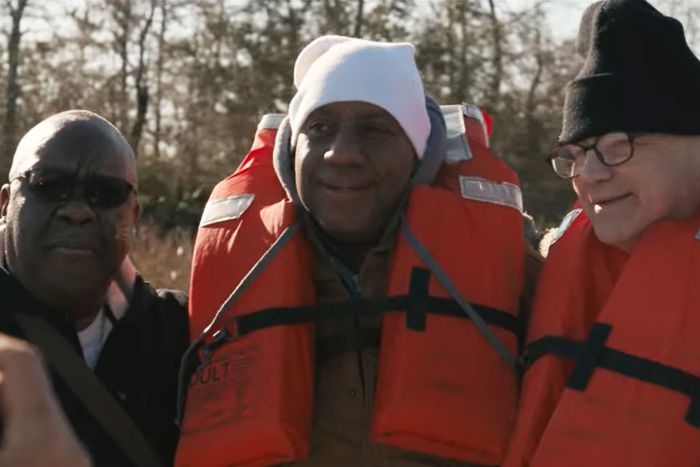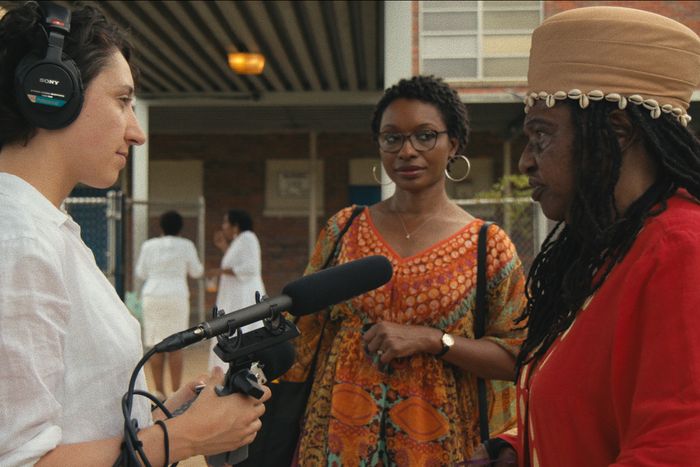
Margaret Brown didn’t believe the wreckage of the Clotilda would be located when she started shooting Descendant. “I thought they weren’t going to find it,” she said. The Clotilda, the last known slave ship to have arrived in the U.S., landed near Mobile, Alabama, in 1860, more than half a century after the international slave trade had been outlawed and made punishable by death. After delivering its cargo of 110 captives from West Africa, the schooner was burned and scuttled to hide the evidence, its existence — including the fact that it was owned by Timothy Meaher, a member of what is still one of the city’s most prominent families — literally and figuratively buried. While the rediscovery of the Clotilda in 2019 becomes the center of Brown’s documentary, what makes Descendant so momentous is its exploration of everything the ship represents, from the suppression of Black history to the immensity of white denial.
Both of those forces are highlighted in the most telling scene of Descendant, which takes place in the waters where the remains of the Clotilda were found. The movie’s subjects descend from the ship’s survivors, many of whom settled in the area after the end of the Civil War, founding the historic Black community of Africatown. The Meahers, who own much of the land around Africatown, remain conspicuously off-screen and silent. But one member does make an unexpected appearance at a 2020 festival thrown by the film’s subjects. An unassuming middle-aged man comes up to introduce himself to Robert Lewis, a descendant of Cudjo Lewis, one of the last survivors of the Clotilda and the Atlantic slave trade. The man’s name is Michael Foster, and he’s a distant cousin of William Foster, who had been the captain of the ship. “It’s kind of odd because my relative caused all of this,” he tells the camera, admitting that he wasn’t sure he’d be welcome, though of course he is, albeit with a certain amount of surprise.
When some of the attendees go out on a boat to the wreckage site, Michael Foster poses for a photo with two Clotilda descendants, and someone points out that the last time a Foster and a Lewis were together there was the night the ship was burned. It’s a congenial moment of extreme discomfort, a reminder of how unprepared even the seemingly willing really are to reckon with an inheritance of historical atrocity. Which is maybe why Foster says what he does about how, in the records, Cudjo Lewis proclaimed that he had some respect for William Foster because he treated the captives well, that his relative was therefore one of the good ones. Diver Kamau Sadiki, standing next to Foster, responds firmly: “A good master, a bad master — it’s equal in my book.”
Brown, a Mobile native, first trained her camera on her hometown to explore its Mardi Gras celebration, the country’s oldest and entirely segregated with separate organizations crowning a white king and queen and a Black king and queen. That 2008 documentary, The Order of Myths, was, in Brown’s words, a work of “white anthropology” about tradition and which aspects of the past get celebrated and buried. There’s a scene in which the Black Mardi Gras queen, Stefannie Lucas, sows the seeds for Descendant by offhandedly noting that she’s a descendant of Clotilda survivors, while the white queen, Helen Meaher, is a descendant of the Clotilda’s owners: “My people were on her people’s ship,” Lucas says. While The Order of Myths is about everything Mobile’s white elite prefers not to talk about, Descendant is about the oral traditions that preserved that history in private over generations, passed down by those who lived it. Brown broke down the process of getting from The Order of Myths to Descendant and capturing that scene of Michael Foster on the water.
Finding the Clotilda.
The existence of the Clotilda had, for a long time, occupied a limbolike place between local history and lore. The first time Brown recalls hearing about the ship wasn’t until she was an adult, working on The Order of Myths. Brown recalls Helen Meaher’s mother referring to the Meahers as “the family that brought the last slave ship.” “It was a whisper,” Brown explains. “She wanted me to know for context, but it was something you didn’t talk about. I didn’t remember learning it in school ever.” One of Descendant’s subjects, Vernetta Henson, echoes this sentiment in an interview onscreen, saying, “As far as I can remember, it’s never been in history books.”
For Henson and other descendants, though, the hush surrounding the Clotilda wasn’t born out of a desire to hide the past but out of fears of violent reprisal. Mobile is also the site of one of the last reported lynchings in the country in 1981. The details were passed down within families or, in the case of Cudjo Lewis, recounted in 1927 to Zora Neale Hurston for what would become Barracoon, a book that wouldn’t find a publisher until 2018 in part because it was written in dialect. The wreckage that is visited late in the film isn’t just a remnant of the past but unignorable proof of half-erased history. As Africantown resident (and former New York Met) Cleon Jones puts it onscreen, “What the ship does is give the rest of the world the evidence that it took place.”
The Clotilda was set on fire in 1860, and it wasn’t until 2018, after the discovery of another wreck that was initially thought but eventually determined not to be the Clotilda, that resources were dedicated to the search. “A lot of people from Mobile started reaching out to me and being like, ‘Are you going to come back? There’s some stuff going on that’s different than meets the eye,’” Brown said. With some financial support from Louis Black, a producer on The Order of Myths, she picked up her camera and hopped on a plane.
Finding the Meahers.
“Hubristically, I thought the Meaher family would talk to me,” Brown said of those early days. “Everyone was trying to get them to comment, and it’s a pretty big family.” She had reason to believe she’d be able to get access to at least one member. In 2007, Brown had followed Helen Meaher through some of Mobile’s most exclusive events as one of the subjects of The Order of Myths. “I didn’t really think the older generation would talk, but I thought Helen would talk to me. We were in communication on Facebook. We’re both runners, and so we would talk about running. Then I would be like, ‘I’m making this film, and it involves your family. I think it would be really beautiful if you guys would comment.’ I listed a lot of reasons why, and she just never responded. She would respond to anything about running stretches, but never anything about” the Clotilda.
The Meahers, who eventually did meet with Clotilda descendants in December after the release of Brown’s film, are only one of the connections between Descendant and The Order of Myths. Kern Jackson, a folklorist at the University of South Alabama who served as a historical adviser on the earlier film, played a larger role in this one as a co-writer, co-producer, and onscreen presence. Jackson connected Brown to some of Descendant’s eventual subjects, including Joycelyn Davis and Vernetta Henson, while she met others, such as Emmett Lewis, at activist meetings. Brown kept trying for the Meahers, but, she said, “at a certain point, it felt like a slap in the face to the community that the Meaher family wasn’t talking. They were like, Man, if they don’t want to talk to us, cool. We lived our lives this long.”
Finding Michael Foster.
Brown didn’t reach out to Foster — that was the work of 60 Minutes, which aired a segment on the Clotilda in 2021. “They wanted him to be their thing,” Brown notes. “60 Minutes had this thing like a reality-TV show where they introduce everybody: Surprise. It was not the approach that I would take.” But Foster turned up at the Spirit of Our Ancestors Festival on his own initiative. “I think he was very disappointed that they were hiding him away, and so he showed up to have a more legit connection and meet people.” Essie Chambers, one of the documentary’s producers, figured out who he was, and the filmmaking team was able to capture when he and Robert Lewis met. It’s an organic moment so perfect that some who’ve seen the film assumed it was arranged. “A journalist asked me if I engineered that,” Brown said.
As to that exchange on the boat, Brown remembers thinking “Wow, dude, really?” when they were filming. But she also notes that what he did in that moment is common. “The sense of shame around slavery is masked in so many ways, and I felt like we saw one of those masks in that scene. I think there is a deep knowledge, for some people at least, that we did something wrong. We were seeing a white-person coping mechanism and him getting corrected at that moment.”
The night before Descendant premiered at Sundance, Brown called Foster to tell him she had included a scene with him that she expected would make people angry. “He was like, ‘Oh, God, what did I say?’ and I told him. He was like, ‘I said that?’ and I said, ‘Yeah.’” But he understood why the moment was important and went on to call the members of the community to apologize. “People in the film who have seen that scene talk about a certain Black exhaustion of just having that happen all the time.”
Finding Margaret Brown.
As the child of a Mobile family, Brown is aware she doesn’t exist outside the history she depicts onscreen. The Order of Myths reveals her relationship to one of its repeated interviewees, Dwain Luce, a former white Mardi Gras king, in a chyron toward the end of the film that identifies him as her grandfather. While she had no desire to replicate Foster’s attempt at smoothing over the past, she said she was looking for some kind of personal basis from which to tell Descendant, even if it was one of direct familial complicity. “Maybe this sounds messed up,” Brown said, “but I was looking for a way to connect myself to the story the same way I was connected to The Order of Myths.”
That connection didn’t surface, so she sought a different approach. Brown did something she had never done before and brought the subjects into the filmmaking process: “I showed people in the movie scenes way before I was done, years before the movie was done, because I wanted them to see what I was doing and make sure, since it’s their story, that they were down with what I was doing.”
“As a white person, I have a lot of blind spots, but I took the lead of the community,” Brown adds. “I have these characters that were so incredible, and they were undergoing this incredible transformation that was literally living history, that they were letting me into. That is the story.”




